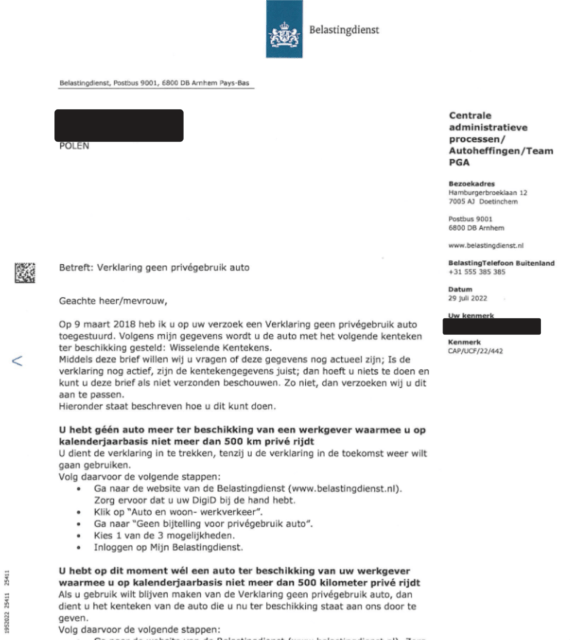Have you received a letter from the Belastingdienst entitled Verklaring geen privégebruik auto? You should react quickly to avoid being charged tax. Keep reading for more information.
Have you received a letter from the Belastingdienst entitled Verklaring geen privégebruik auto? You should react quickly to avoid being charged tax. Keep reading for more information.
If you have received a car from your employer, your employer must add your allowance as a private individual to your salary (so-called bijtelling ). The benefit you have privately is therefore seen as salary. After all, when you privately drive a company vehicle, you do not have to buy and maintain your own car. By adding a fictitious amount to your salary, your net salary will therefore be lower. This may sound complicated, however, the authorities are entitled to charge you additional tax.
Verklaring geen privégebruik auto
However, if you do not drive more than 500 kilometres a year privately in your employer's vehicle, the authorities cannot charge you additional tax. You can notify your employer and the tax authorities of this in a special written declaration for the tax year in question. From the moment you submit your completed and signed declaration, your employer will no longer withhold the allowance.
Convincing evidence
If you have not submitted a declaration that you are not using your vehicle for private purposes, you will still have to prove that you have not driven more than 500 kilometres for private purposes. The best way to prove this is through automatic trip recording (e.g. GPS monitoring). In addition to the recording of journeys, your mileage log is also an important part of the evidence and all other matters that may indicate that you were somewhere with your vehicle during a certain period of time. Such as fuel coupons, garage bills, parking tickets, etc. So ensure you always have these documents on file; the tax authorities can ask for them anytime!
Change of employer during the year
It is worth knowing that the 500-kilometre limit applies to the calendar year. If you did not have a vehicle at your disposal for the whole year, you must calculate the kilometres proportionally. For example, if you only had a company car for 6 months and drove 300 kilometres, the total is calculated for 12 months. In this case, you must simply pay a surcharge for the months in which you had the vehicle at your disposal.
Example
Suppose you change employer on 1 July, halfway through the tax year. Employer A provided you with a car for the period January to June, which you drove privately for 200 kilometres during these 6 months.
Continuing this trend, you would privately drive a total of 400 kilometres over the course of the year. Therefore, you cannot benefit from the exemption from charging tax.
You get another car
Suppose you drive 400 kilometres privately between 1 January and 1 August in car A, and on 1 August you get another car, let's call it: car B, in which you do not do any private kilometres.
In this case, the employer must calculate the allowance for both cars for the period in which you had the vehicle. After all, with car A, you would exceed the 500 kilometer limit for the entire year, so
the employer has the right to charge a bonus for the entire year
If it later turns out that you have wrongly exercised your exemption right, the tax authority will issue an additional tax ruling. In this case, you will still have to pay the allowance
due for the period in question. The Tax and Customs Administration (elastigndienst) has the right to look back five years. If you have misused the statement because you have driven more than 500 private kilometres, an inspector
can impose a fine of €3936. If you have false evidence or if your record of kilometres is incorrect, the fine is a maximum of €4920.
If you are looking for help with making a statement and avoiding a fine - contact us! Write a message to hello@aangifte24.com - we can help!


